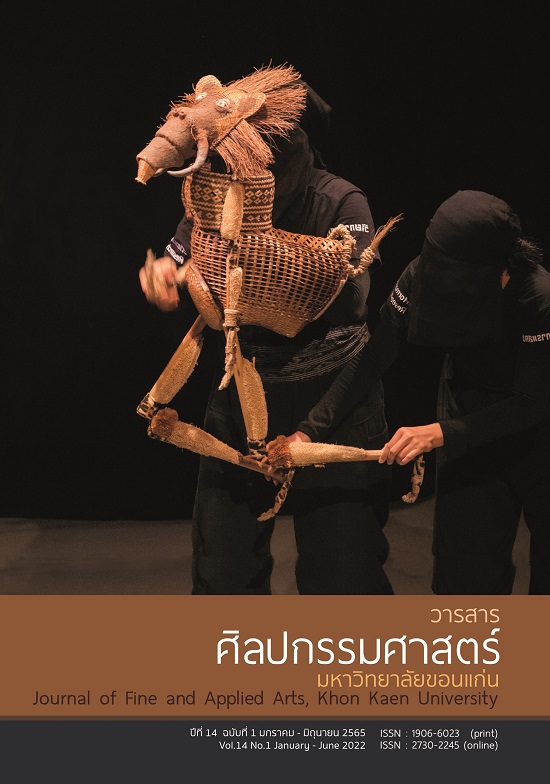Musical Forms and Change of Music for Lam Phaya
Main Article Content
Abstract
The research, Musical Forms and Change of Music for Lam Phaya, aimed at : 1) The study Form of Music for Lam Phaya. 2) The study Change of Music for Lam Phaya.
The research tools included an interview form and an observation form. Written document and field data were collected. Field data were obtained through interviews and observations from 9 key-informants, 10 casual informants, and 10 general informants in Karasin Province and Mukdahan Province.The research From November 2016 to 30 July 2020, The data were checked for their accountability with triangulation technique, analyzed according to the given objectives, and the results of the study were presented in a descriptive analysis form.
The result of research.the musical forms for music for Lam-Phaya. Divided into 2 sides 1) Musical instruments, Consists of musical instruments that are used in traditional music is Khaen mouth organ and Phin Responsible for Melody The drums and cymbals are responsible for directing the rhythm. the musical forms Lam Phaya. Consisting of 2.1) There are 2 types of rhythm: semi-independent and fixed rhythm. 2.2) There are 2 types of melody which are Traditional times are slow melody. The use of sounds and poems is not systematic. The melody of the phaya has the characteristics of "repeat melody". There are 4 types of melodies found in the phaya. is the preceding melody, Intro main theme and closing section and the melody progressing along with the singing which is the melody operation of the instrument and molam. repeatedly while singing 2.3) The lam-phaya prosody content has 4 characteristics. The Intro, main, theme, and closing section. 2.4) Harmony characteristics found that molam's singing of the relationship between the melody of the poem Lam Melody of the Phin and khaen playing. Which has children falling in the same tune 2.5) The pattern is found to A A A pattern, the pattern of all types of musical instruments use the same And also found that various falling balls will fall at the same rhythm. 2.6) Sentences of lam phaya's Verse Found that with rhyme in the same tone pattern has diversity and there are many rhyme-tones rhymes is in the form of music.
The change in the music of lam phaya, concluded that molam phaya is rapidly changing. Both musical instruments, which is popular with western musical instruments very fast tempo. and bring thai molam folk songs to play more in the band, Causing the original melodies to fade most will focus on the form of a concert rather than the traditional. as well as the creation of artists to serve the society even more Allowing artists to have a good income from lam phaya performances.
Article Details

This work is licensed under a Creative Commons Attribution-NonCommercial-NoDerivatives 4.0 International License.
Content and information in articles published in the Journal of Fine and Applied Arts of Khon Kaen University is regarded as the opinion and sole responsibility of the author(s) directly; therefore, editors are not obliged to agree to or share any responsibility with regard to the content and information that appears within these articles.
All articles, information, content, image, etc. that have been published in the Journal of Fine and Applied Arts of Khon Kaen University is the copyright of the Journal of Fine and Appllied Arts of Khon Kaen University. Any person or organization who wishes to distribute all or parts of the articles for further dissemination or other usage must first receive permission from the Journal of Fine and Applied Arts of Khon Kaen University before proceeding to do so.
References
เจริญชัย ชนไพโรจน์. (2526), ดนตรีพื้นบ้านอีสาน. กรุงเทพฯ : คณะมนุษยศาสตร์และสังคมศาสตร์ มหาวิทยาลัยศรีนครินทรวิโรฒ.
เจริญชัย ซนไพโรจน์. (2541). คู่มือการเป่าแคนเบื้องต้น, มหาสารคาม :คณะมนุษยศาสตร์และสังคมศาสตร์ มหาวิทยาลัยมหาสารคาม.
สงวน ศรีอระพิมพ์. (2534), ลำผญาย่อยหัวดอนตาล, วิทยานิพนธ์ปริญญาศิลปศาสตรมหาบัณฑิต สาขาวิชาไทยคดีศึกษา คณะมนุยศาสตร์และ
สังคมศาสตร์ มหาวิทยาลัยศรีนครินทรวิโรฒ มหาสารคาม
สัญญา สัญญาวิวัฒน์. (2536). ทฤษฎีสังคมวิทยา การสร้าง การประเมินค่าและแนวการใช้ประโยชน์. กรุงเทพฯ : จุฬาลงกรณ์มหาวิทยาลัย.
สัญญา สัญญาวิวัฒน์. (2540). ทฤษฎีสังคมวิทยา เนื้อหาและแนวการใช้ประโยชน์เบื้องต้น. กรุงเทพฯ : จุฬาลงกรณ์มหาวิทยาลัย.
สัญญา สัญญาวิวัฒน์. (2542). ทฤษฎีสังคมวิทยา: การสร้าง การประเมินค่า และการใช้ประโยชน์. กรุงเทพฯ : สำนักพิมพ์แห่งจุฬาลงกรณ์มหาวิทยาลัย
สุภางค์ จันทวานิช. (2546). การวิเคราะห์ข้อมูลในการวิจัยเชิงคุณภาพ. พิมพ์ครั้งที่ 2 กรุงเทพฯ : สำนักพิมพ์แห่งจุฬาลงกรณ์มหาวิทยาลัย.


